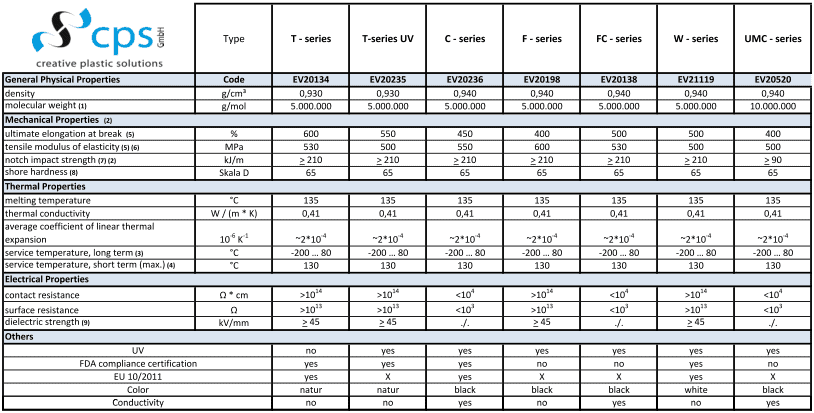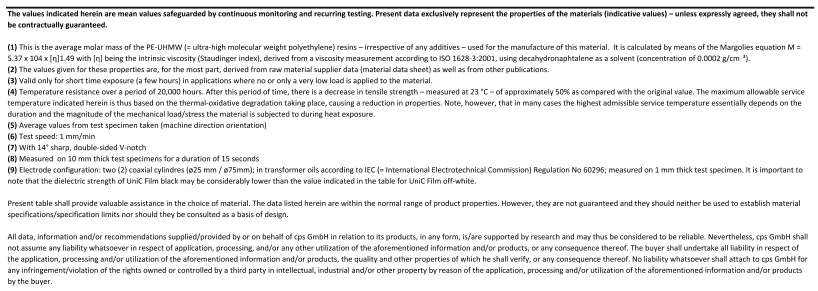Use of Plastic Film in Rubber Hoses
Plastic films are used with two kinds of rubber hoses: on the one hand, as interior lining materials for transport hoses for chemical and food products and, on the other hand, as exterior lining materials for high-pressure and hydraulic hoses.
Hoses with plastic film interior linings are manufactured on steel spindles. The plastic lining is in direct contact with the process liquids/gases/materials transported in the hoses and improves the quality of the latter as the plastic is extraordinarily chemical-resistant, provides high-level barrier protection, and is classified and approved for direct contact with foods. For this reason, the use of plastic films as an interior lining material is widely spread. Hoses with plastic film interior lining for chemicals have been known for approximately 20 to 30 years already. They were developed as their chemical resistance was considerably higher compared to synthetic standard rubber. The first plastic film generation based on extruded high-pressure as well as low-pressure polyethylene (= PE) – however, its utilization was limited as far as its maximum operating temperature was concerned. An improved temperature resistance was achieved by admixing peroxides to the plastic. The peroxides cross-linked the polyethylene during the vulcanization process, thus increasing the maximum operating temperature properties of the hose. Significant disadvantages of these so-called PE-X lining materials was the missing cross-linking homogeneity, a shorter lifetime/durability as well as insufficient flexibility as the lining material had to be applied in two to three layers, with a layer thickness of 0.40 to 0.50 mm each. Ever since the beginning of the nineties, UHMWPE (= ultra-high molecular weight polyethylene – also abbreviated as UPE) has revolutionized the market as it allows for thinner (2 x 0.20 mm), highly consistent and flexible solutions. The current market trend continues to point towards increased flexibility with at least constant chemical resistance properties. For this special purpose, CPS GmbH have developed the so-called UF Series – a highly flexible plastic lining film which presently is being launched to the market with great success.
Exterior lining materials for hydraulic and/or high-pressure hoses continue to become more and more important. Hydraulic hoses – such as for very compact excavators – and high-pressure hoses – such as for forestry machinery and the mining industry – are exposed to extremely high levels of abrasion which causes pre-mature wear/fatigue or bursting of the hoses. The replacement of the hoses – with the machine being out of operation for more than one day in general – is so expensive that the use of exterior linings is considered a cost-favourable alternative to lengthen the lifetime/durability of hoses. UHMWPE has got the ideal properties to make rubber hose coverings more abrasion-resistant and to reduce the friction coefficient between the hoses as well as between hose and steel considerably. UHMWPE is either applied like a cigarette tube, with overlapping seams, or wound up in a spiral pattern. Previous solutions, such as the application of polyamide tubes or extruded thermoplastic polyurethane (= TPU) were either too labour-intensive (the tubes had to be applied prior to hose end connection) or too expensive (due to the utilization of thermoplastic polyurethane with a layer thickness of 2 to 3 mm). For this reason, hoses with a UHMWPE covering layer are presently the standard solution for hose applications demanding highest abrasion protection properties.
The product matrix


CPS GmbH Competence in Rubber Hose Plastic Linings
The leading market position of CPS GmbH as a supplier of plastic interior lining films for chemical and food transport hoses as well as of exterior linings for high-pressure and hydraulic hoses is a result of close customer relations, a profound knowledge of the market as well as on a wide range of customized formulations which have been optimized for specialized applications. Furthermore, progress and success of CPS GmbH base upon their wide range of experience and their comprehensive activities – from research and development to production and sales.
Since CPS GmbH primarily focuses on hose industry demands and endeavours to pro-actively develop new, functional and cost-effective total solutions, our company is more than just a mere sales organization distributing in-house manufactured films. In this respect as well as due to our extensive product portfolio, we distinctly differ from our competitors.
Our lining materials product range exclusively contains films with a unique composition and combination of properties – thus the brand name UniC film. For specialized applications special formulations have been developed (Series).
CPS GmbH Interior Lining Films
The majority of the lining materials in our product portfolio are formulations basing on ultra-high molecular weight polyethylene (= UHMWPE or UPE) and high molecular weight polyethylene (HMWPE). The most current formulations base on specialized, polyolefin matrices/dies developed in-house. In order to avoid explosions in chemical plants due to electrostatic discharges a good electrical conductivity of the lining materials is essential. For this reason, all our films possess the highest conductivity properties of all lining films currently known in the market. In addition to that, most of our products are highly abrasion-resistant and clean, thus allowing for direct contact with foods (milk-, fat-, alcohol-based foods alike). The ultra-flexible series, UF Series, is our latest development in order to offer considerably more flexible hoses with only minimal concessions as far as their chemical resistance is concerned.
CPS GmbH interior lining films do not require any adhesives or separate adhesive films for adhesion. During the vulcanization process of the hose in a steam autoclav – typically one hour exposure time at 150 °C – our films bond with the top rubber layer and the overlapping seams of the film bond with each other, thus to produce a continuous protective tube. This feature provides protection against chemical reactions and the diffusion of liquids, granulates or powders to all interior rubber layers and hose reinforcements.
In general, our films have a standard strength of 100 to 400 µm and a standard width of 30 to 350 mm. Standard rolls have a length of 400 running meters – upon request, however, lengths of 100 to 2,000 running meters may be supplied.
Food Contact
Our films are often used in transport hoses for a wide range of foods.
In 1993, the BAM Berlin (= Bundesanstalt für Materialforschung und -prüfung) (= German Federal Institute for Materials Research and Testing in Berlin) confirmed the compliance of our films upon testing them to meet the requirements of the KTW-Leitlinie (= Leitlinie zur hygienischen Beurteilung von organischen Materialien im Kontakt mit Trinkwasser) (= German Guideline for the Hygienic Evaluation of Organic Materials in Contact with Drinking Water) and granted their release thereafter. For several years now, the certification of the entire hose has been mandatory though. And for this reason, CPS GmbH have not re-certified their hoses – however, they provide support to their customers in the hose certification process.
Mechanical Properties
The utilization of additives increases the hose surface functionality on the one hand – on the other hand this results in a loss of mechanical properties such as elongation at break and tensile stress at break though. CPS GmbH have recently reworked their entire product portfolio and developed a series of new formulations which minimize the loss of the aforementioned mechanical properties.
CPS GmbH UHMWPE Lining Materials for Exterior Hose Linings
The stabilization of UHMWPE films, used for exterior hose linings, is a crucial factor in order to increase UV and fatigue resistance considerably, for which reason all UC Plastic exterior lining films are stabilized. Compared to non-stabilized UHMWPE competitor products/films, our films have an up to five times higher lifetime/durability, without any fissuring on the layer surface. In order to prevent explosions due to electrostatic discharges, for example in the mining sector, a good electrical conductivity of the lining materials is essential. For this reason, CPS GmbH films possess the highest and most constant conductivity properties of all lining films currently available in the market. Our latest developments have resulted in highly flexible UHMWPE formulations (FF and FFC Series) which offer significantly increased tensile strength properties.
In general, our films have a standard strength of 100 to 400 µm and a standard width of 30 to 350 mm. Standard rolls have a length of 400 running meters – upon request, however, lengths of 100 to 2,000 running meters may be supplied.
Tensile/Tear Resistance and Scratch Resistance of Film
Upon utilization of our thermoplastic UniC films as a covering layer of rubber hoses they always constitute the stiffest/most rigid component of the entire hose system, extending plastically instead of elastically upon bending. If, in case of bending, sharp objects get into contact with the surface layer, the plastic layer may be damaged or tear in these impact areas. The very high stress concentration in this area substantially increases the risk of rupturing the entire hose construction down to the reinforcement fibre thus reducing the lifetime/durability of hoses with UHMWPE exterior covering layers notably. In order to prevent these adverse effects, CPS GmbH have developed especially flexible and highly tear-resistant formulations, the so-called FF and FFC Series (= flexibilized F/FC Series). These formulations provide for significantly higher tensile/tear resistance, reduced E module as well as increased tensile strength at break properties.
With only minimal abrasion resistance compromises (Sand-Slurry Test Method) the new films’ flexibility and tensile/tear resistance properties have been considerably improved. Therefore, we are convinced that the FF and FFC Series UniC films will set new standards for exterior hose linings in the future.
Wear-Resistant UHMWPE Film Strips for Vehicle Window Rubber Seals
UHMWPE film strips are used in window guide channels of vehicle window rubber seals where the glass window has abrasive contact with the sealing. These UHMWPE film strips contribute to a remarkable reduction of the friction coefficient as well as to a considerable increase of the abrasion resistance and lifetime/durability of window rubber seals. Another inherent property of UHMWPE is the extraordinarily high melting viscosity: even with temperatures exceeding the melting temperature (of approximately 138 to 141 °C) UHMWPE will not melt. This unique property allows for very high processing temperatures – for example, if corner modules of window rubber seals are cast within up to two minutes at thermal stress conditions of up to 200 °C. Alternative materials, such as polypropylene (= PP), rapidly melt in such conditions and ripple – thus, they are not qualified to satisfy the sealing requirements in an adequate manner. Consequently, the system cost of UHMWPE strips is significantly lower although UHMWPE, by the running meter, is far more expensive than polypropylene. Moreover, waste volumes in UHMWPE processing are far lower compared to polypropylene processing and flock finishing. In general, our wear-resistant UHMWPE film strips have standard dimensions of 0.50 mm by 8 mm and are supplied on cross-wound reels containing up to 12,000 running meters.
